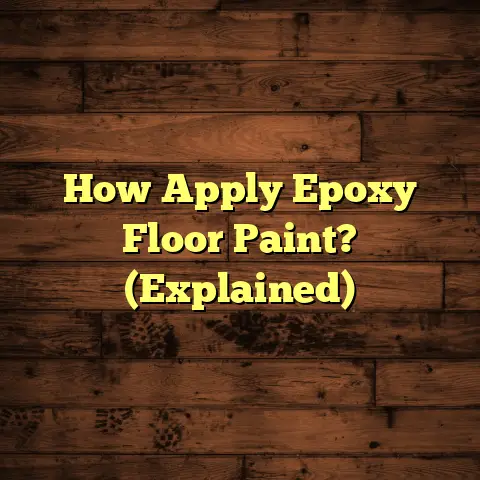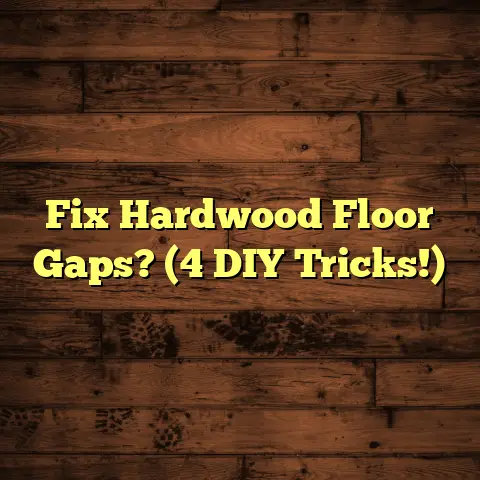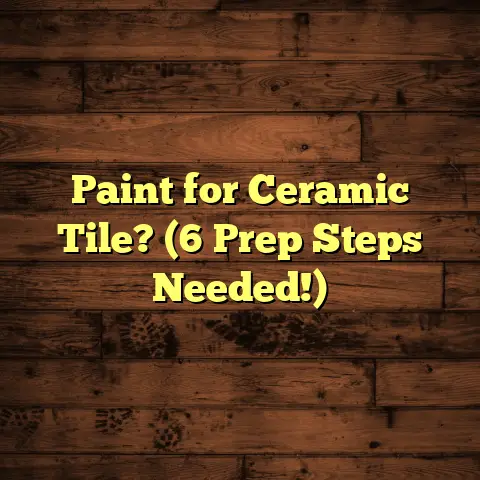Sticky Hardwood? Clean It Now! (1 Trick Pro’s Use!)
It’s like your floor is giving you a subtle, yet persistent, high-five of grime.
Trust me, you’re not alone. I’ve seen it all in my years as a flooring contractor. From pet accidents to kids’ sticky spills, hardwood floors face a daily barrage of challenges.
And while hardwood floors are stunning, adding warmth and value to any home, they need our love and attention. A well-maintained hardwood floor isn’t just about aesthetics; it’s about preserving its functionality and longevity.
That subtle stickiness? It’s more than just annoying. It’s a sign that dirt, grime, and moisture are wreaking havoc on your floor’s surface.
Left unchecked, it can damage the finish, leading to costly repairs or even replacement.
But don’t panic! I’m here to share a tried-and-true trick I’ve used for years. This method tackles that stickiness head-on, restoring your hardwood to its former glory.
Ready to learn the secret? Let’s dive in!
Section 1: Understanding Hardwood Textures
Okay, so you’ve got hardwood floors. But did you know there’s a whole world of textures out there? We’re not just talking about smooth vs. not-smooth.
Think of it like this: each texture has its own personality, its own way of interacting with the world – and, unfortunately, with dirt.
Let’s break down some common types:
-
Smooth Finish: The classic. Sleek, elegant, and relatively easy to clean. But, those smooth surfaces can really show every smudge and sticky spot.
-
Hand-Scraped: This texture has a rustic, time-worn feel. The intentional imperfections and grooves add character, but they can also trap dirt and debris if you’re not careful.
-
Distressed: Similar to hand-scraped, distressed floors have an aged look, often with knots, wormholes, and other “flaws.” These features add visual interest, but they can also make cleaning a bit more challenging.
-
Wire-Brushed: This texture involves using a wire brush to remove the soft grain from the wood, leaving a more pronounced grain pattern. It’s a great look, but those deeper grooves can hold onto dirt.
So, why do floors get sticky in the first place? It’s usually a combination of factors:
-
Spills: Obvious, right? Juice, soda, wine – they all leave behind a sticky residue if not cleaned up immediately.
-
Residue from Cleaning Products: Ironically, cleaning your floors can sometimes make them sticky. Harsh chemicals or using too much soap can leave behind a film that attracts dirt.
-
Humidity: Moisture in the air can react with the finish on your floors, creating a sticky surface. This is especially common in humid climates or during the summer months.
Imagine a hand-scraped floor after a humid summer. The grooves are practically begging for dust and grime to settle in, creating a sticky, unpleasant mess.
On the other hand, a smooth floor might just have a thin film of sticky residue on the surface, which is easier to address.
Understanding your floor’s texture is the first step to effectively battling stickiness.
It’s like knowing your enemy before you go to war!
Section 2: The Science Behind Stickiness
Let’s get a little nerdy for a second. What actually makes hardwood floors sticky? It’s not just magic (though sometimes, it feels like it disappears with magic!).
The stickiness often comes down to the chemical composition of the floor’s finish and how it interacts with the environment.
Most hardwood floors are finished with either:
-
Polyurethane: This is a durable, water-resistant finish that’s commonly used in homes. However, over time, polyurethane can break down, becoming more porous and prone to trapping dirt.
-
Varnish: Similar to polyurethane, varnish provides a protective layer. But it can also be susceptible to damage from harsh chemicals or excessive moisture.
-
Oil-Based Finishes: These finishes penetrate the wood, providing a natural look and feel. They’re often easier to repair than polyurethane or varnish, but they require more frequent maintenance.
When these finishes are exposed to humidity, temperature fluctuations, and everyday wear and tear, they can start to break down.
This creates a microscopic, sticky surface that attracts dust, dirt, and other contaminants.
Think of it like this: the finish is like a shield protecting your wood. But over time, that shield gets worn down, leaving your floor vulnerable.
I remember one client, Mrs. Davison, who had beautiful, dark-stained hardwood floors in her living room.
She complained that they were always sticky, no matter how much she cleaned them.
After inspecting her floors, I realized that the polyurethane finish was severely degraded, likely due to years of using harsh cleaning products.
The finish was so porous that it was practically absorbing dirt and grime.
I recommended refinishing the floors with a high-quality, water-based polyurethane, and the difference was night and day.
Her floors were no longer sticky, and they looked brand new!
Environmental factors also play a significant role. High humidity can cause the wood to expand and contract, which can damage the finish and create microscopic cracks where dirt can accumulate.
Temperature fluctuations can also cause the finish to become brittle and prone to chipping, further exacerbating the problem.
So, understanding the science behind stickiness is crucial. It helps you choose the right cleaning products, maintenance techniques, and preventative measures to keep your hardwood floors looking and feeling their best.
Section 3: The One Trick Professionals Use
Alright, let’s get to the good stuff. The moment you’ve been waiting for!
What’s the one trick that I, and many other professional flooring contractors, use to tackle sticky hardwood floors?
It’s not some fancy, expensive product or complicated technique. It’s surprisingly simple, yet incredibly effective:
Using a Vinegar and Water Solution with Microfiber Mop
Yes, you read that right. Plain old white vinegar and water. It’s a natural, non-toxic, and readily available solution that works wonders on sticky hardwood floors.
Here’s why it works:
-
Vinegar is a natural degreaser: It cuts through sticky residue and grime without damaging the finish.
-
Vinegar is slightly acidic: This helps to dissolve mineral deposits and hard water stains that can contribute to stickiness.
-
Microfiber mop: These mops are designed to trap dirt and dust without scratching the floor’s surface.
Here’s a step-by-step guide on how to execute this trick effectively:
Materials Needed:
- White vinegar
- Warm water
- Two buckets (one for cleaning solution, one for rinsing)
- Microfiber mop
- Spray bottle (optional)
- Soft cloths or towels
Step 1: Prepare the Solution
Mix equal parts white vinegar and warm water in one of the buckets.
I usually start with 1 cup of vinegar and 1 cup of water. You can adjust the amount depending on the size of your area.
Step 2: Prepare the Floor
Before you start mopping, sweep or vacuum the floor thoroughly to remove any loose dirt, dust, or debris.
This prevents you from just pushing the dirt around with the mop.
Step 3: Mop the Floor
Dip the microfiber mop into the cleaning solution, making sure to wring it out thoroughly.
You want the mop to be damp, not soaking wet. Excess water can damage hardwood floors.
Mop the floor in sections, using a back-and-forth motion. Pay special attention to areas that are particularly sticky or dirty.
Step 4: Rinse the Mop
After each section, rinse the mop in the second bucket of clean water. This prevents you from spreading dirty water back onto the floor.
Wring out the mop thoroughly before dipping it back into the cleaning solution.
Step 5: Dry the Floor
After mopping, use a clean, dry microfiber cloth or towel to dry the floor. This helps to prevent water spots and streaks.
If you have a spray bottle, you can lightly spray the cleaning solution onto the floor and then wipe it dry with a cloth.
Adapting the Method for Different Textures:
-
Smooth Floors: This method works great on smooth floors. Just be sure to wring out the mop thoroughly to prevent excess water from pooling on the surface.
-
Hand-Scraped or Distressed Floors: These textures require a bit more attention. Use a soft-bristled brush to gently scrub the grooves and crevices to remove any trapped dirt. You can also use a spray bottle to apply the cleaning solution directly to these areas.
-
Wire-Brushed Floors: Similar to hand-scraped floors, wire-brushed floors can trap dirt in the grooves. Use a soft-bristled brush to clean these areas, and be sure to dry the floor thoroughly to prevent water from seeping into the wood.
Important Tips:
- Test in an inconspicuous area first: Before cleaning the entire floor, test the solution in a small, hidden area to make sure it doesn’t damage the finish.
- Don’t use too much vinegar: While vinegar is a great cleaner, too much of it can damage the finish on your floors. Stick to the 50/50 ratio.
- Don’t use a steam mop: Steam mops can damage hardwood floors by forcing moisture into the wood.
- Dry the floor thoroughly: Excess moisture can lead to warping, cupping, and other problems.
I’ve seen this simple trick transform countless sticky, grimy hardwood floors into sparkling, clean surfaces.
It’s a safe, effective, and affordable way to keep your floors looking their best.
Section 4: Maintaining a Clean and Non-Sticky Surface
Okay, so you’ve tackled the stickiness. Awesome! But the job’s not done.
Maintaining a clean and non-sticky surface is an ongoing process. It’s like brushing your teeth – you can’t just do it once and expect perfect results forever.
Here are some routine maintenance tips to prevent stickiness from returning, focusing on preserving the texture of your floors:
-
Sweep or Vacuum Regularly: This is the most basic, yet most important step. Sweep or vacuum your floors at least once a week to remove loose dirt, dust, and debris. Use a soft-bristled brush or a vacuum with a felt attachment to avoid scratching the floor.
-
Clean Up Spills Immediately: Don’t let spills sit on your floor. The longer they sit, the more likely they are to leave behind a sticky residue. Wipe up spills immediately with a clean, damp cloth.
-
Use Doormats and Area Rugs: Place doormats at all entrances to trap dirt and debris before they get onto your floors. Use area rugs in high-traffic areas to protect the finish.
-
Choose the Right Cleaning Products: Avoid using harsh chemicals, abrasive cleaners, or ammonia-based products on your hardwood floors. These can damage the finish and leave behind a sticky residue. Stick to the vinegar and water solution or a cleaner specifically designed for hardwood floors.
-
Mop Regularly (But Not Too Often): Mop your floors every 1-2 weeks, or as needed. Be sure to wring out the mop thoroughly to prevent excess water from damaging the wood.
-
Control Humidity: High humidity can contribute to stickiness. Use a dehumidifier in humid climates or during the summer months to keep the humidity level in your home between 30% and 50%.
-
Consider a Professional Cleaning: Once or twice a year, consider hiring a professional flooring contractor to deep clean your hardwood floors. They have the equipment and expertise to remove stubborn dirt and grime without damaging the finish.
Choosing the right cleaning products is crucial. Here’s a quick guide based on flooring texture:
-
Smooth Floors: A gentle, pH-neutral cleaner or the vinegar and water solution works well.
-
Hand-Scraped or Distressed Floors: Look for cleaners specifically designed for textured floors. These cleaners often have a lower pH and won’t leave behind a residue in the grooves.
-
Wire-Brushed Floors: Similar to hand-scraped floors, use a cleaner designed for textured surfaces.
Regular cleaning schedules can significantly prolong the life and appearance of your hardwood floors.
It’s like giving your floors a regular spa day!
I’ve had clients who followed these simple maintenance tips for years, and their floors still looked brand new.
One homeowner, Mr. Johnson, told me that he started using the vinegar and water solution after I recommended it. He said his floors had never looked better.
He was amazed at how easily it removed the sticky residue and how it left his floors with a natural shine.
Another client, Mrs. Smith, said that she used to dread cleaning her hardwood floors because they always seemed to get sticky.
But after she started using the right cleaning products and following a regular cleaning schedule, she found that it was much easier to keep her floors looking clean and beautiful.
Section 5: Addressing Common Misconceptions
Let’s bust some myths! There’s a lot of misinformation out there about hardwood floor maintenance.
I’ve heard it all, from using olive oil to “moisturize” the wood (please don’t!) to believing that all hardwood cleaners are created equal (they’re definitely not!).
Here are some common misconceptions and the truth behind them:
Myth #1: You can use any cleaning product on hardwood floors.
Truth: Nope! Harsh chemicals, abrasive cleaners, and ammonia-based products can damage the finish and leave behind a sticky residue. Always use a cleaner specifically designed for hardwood floors or the vinegar and water solution.
Myth #2: You should wax your hardwood floors regularly.
Truth: Waxing hardwood floors was common in the past, but it’s generally not recommended for modern finishes. Wax can build up over time, creating a dull, sticky surface. If you have waxed floors, you may need to strip the wax before cleaning them.
Myth #3: Steam mops are safe for hardwood floors.
Truth: Steam mops can damage hardwood floors by forcing moisture into the wood. This can lead to warping, cupping, and other problems. Avoid using steam mops on hardwood floors.
Myth #4: You should use a lot of water when mopping hardwood floors.
Truth: Excess water can damage hardwood floors. Always wring out the mop thoroughly before mopping, and dry the floor immediately after cleaning.
Myth #5: Scratches and dents can’t be repaired.
Truth: While deep scratches and dents may require professional repair, minor scratches and dents can often be repaired with a touch-up kit or a wood filler.
Now, let’s tackle some common questions:
Q: How often should I clean my hardwood floors?
A: Sweep or vacuum at least once a week, and mop every 1-2 weeks, or as needed.
Q: What’s the best way to remove sticky residue from hardwood floors?
A: The vinegar and water solution is a great option. You can also try using a cleaner specifically designed for removing sticky residue.
Q: How can I prevent my hardwood floors from getting sticky in the first place?
A: Follow the routine maintenance tips outlined in Section 4, including sweeping or vacuuming regularly, cleaning up spills immediately, and using the right cleaning products.
Q: What should I do if my hardwood floors are severely damaged?
A: If your hardwood floors are severely damaged, it’s best to consult with a professional flooring contractor. They can assess the damage and recommend the best course of action, whether it’s repairing the floors or replacing them.
Q: Can I use essential oils in my cleaning solution?
A: While some people like to add essential oils to their cleaning solution for fragrance, it’s important to be cautious. Some essential oils can damage the finish on hardwood floors. If you choose to use essential oils, test them in an inconspicuous area first.
Conclusion
So, there you have it! The secret weapon in the fight against sticky hardwood floors: a simple vinegar and water solution.
It’s a tried-and-true method that I’ve used for years, and I’m confident that it can help you restore your floors to their former glory.
But remember, addressing sticky hardwood floors is just one part of the equation. Maintaining their texture and preventing stickiness from returning requires ongoing effort and attention.
By following the routine maintenance tips outlined in this article, you can keep your floors looking clean, beautiful, and non-sticky for years to come.
Don’t let sticky floors get you down! Take action today and implement the cleaning method I’ve shared.
You’ll be amazed at the difference it makes. Trust me, there’s nothing quite like the feeling of walking across a clean, smooth, and non-sticky hardwood floor.
It’s a feeling of pride, accomplishment, and satisfaction. It’s a feeling that says, “I take care of my home, and I take pride in its appearance.”
So go ahead, give your hardwood floors the love and attention they deserve. You’ll be rewarded with a beautiful, comfortable, and inviting home that you can be proud of.





